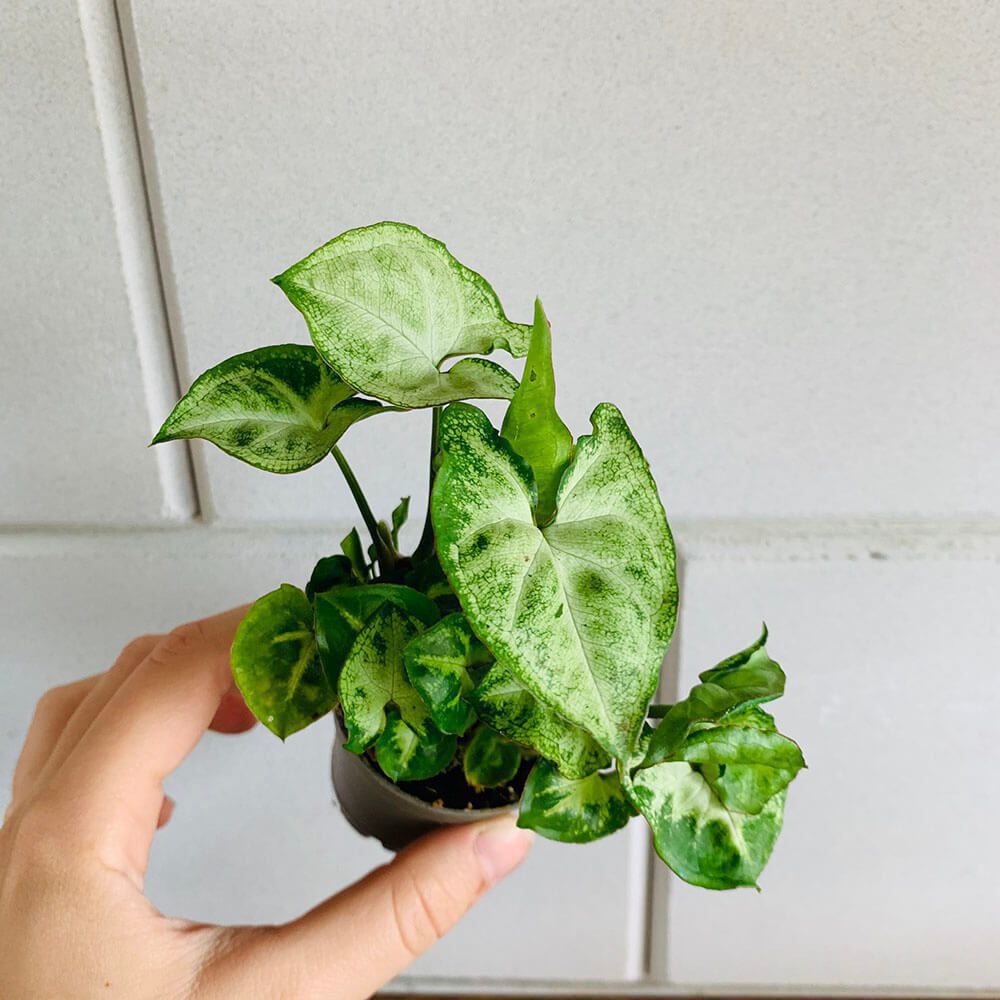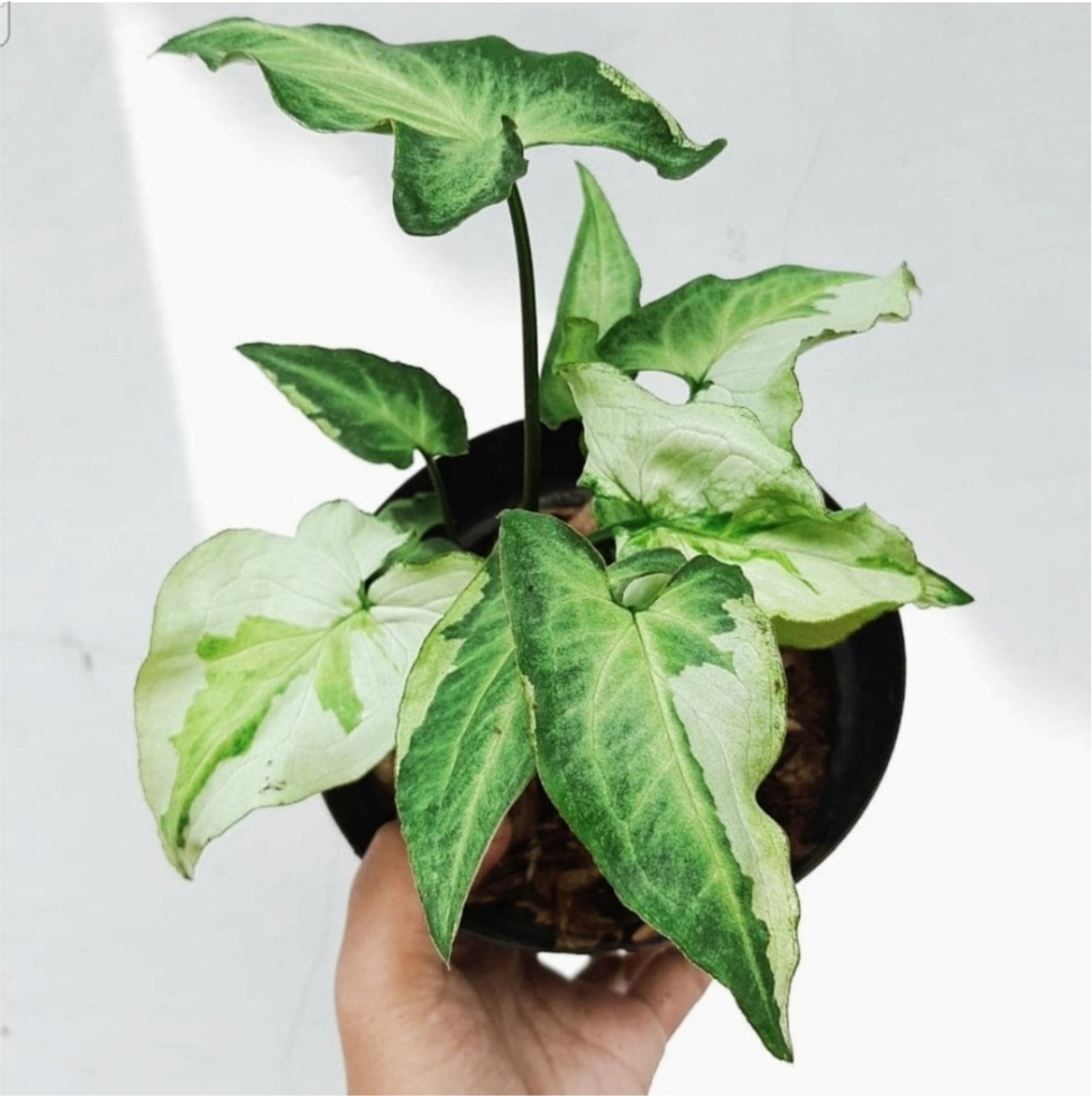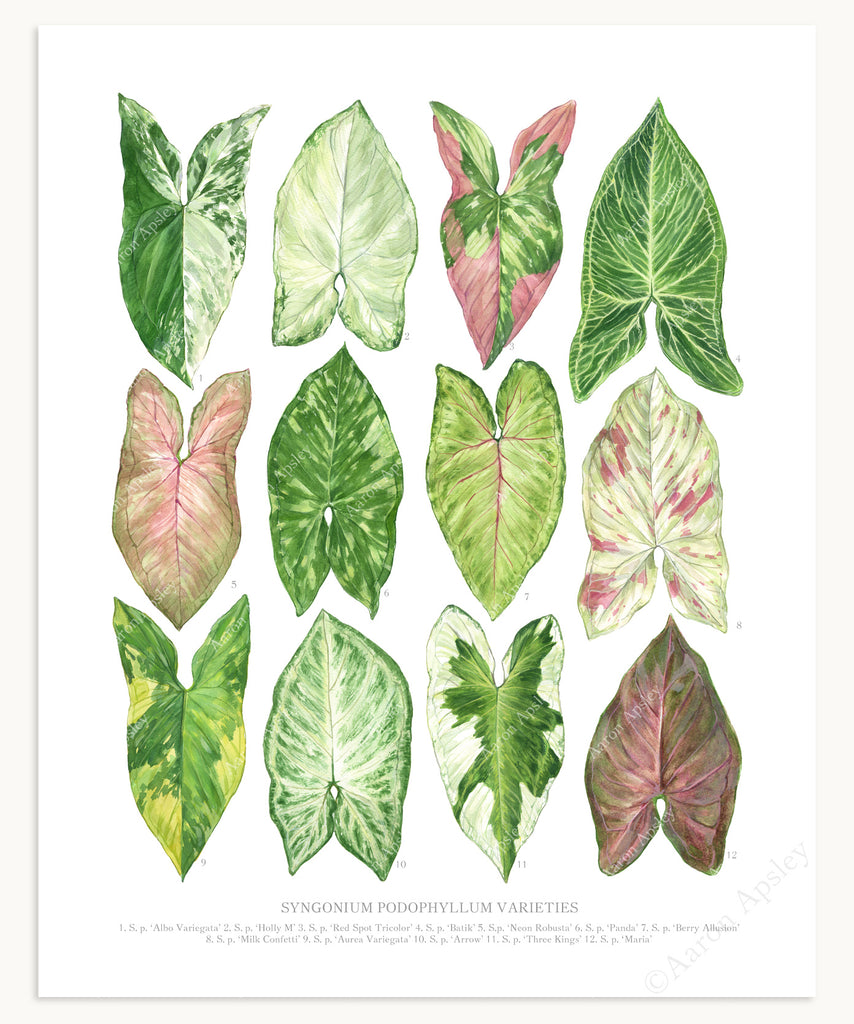
Syngonium plants are popular because of the fun shape of the leaves. When these plants are young they have arrow shaped leaves. As if that wasn’t enough, the leaves also feature fun patterns and colors. Most species have variegated leaves, but there are also specimens with pink, purple or yellow available.In general, Syngoniums are known as fairly easy to care for houseplants that grow fairly quickly. You can read about the right approach to care here. You will also find information about the Syngonium in the wild, its growth habit and an answer to frequently asked questions.
Table of Contents
Syngonium care
Syngonium location and light
The correct location is one of the most important parts of the maintenance of the Syngonium. The location determines how much and what type of light the plant receives. The type of light means: shadow, indirect sunlight or direct sunlight. The very best thing to give the Syngonium is a location where it gets some direct sunlight in the morning and evening and indirect sunlight during the afternoon.
The reason is that this way you are mimicking the natural habitat as closely as possible. In the wild, Syngoniums grow under tall trees of the tropical rainforest. Only when the sun is very low, in the morning and evening, does the sunlight reach the leaves. During the day, when the sun is high, it does not. If you place the Syngonium in the sun at noon, the leaves may burn. You can see this by brown or black spots on the leaves.
So avoid the full midday sun, but be sure to give it some sunlight in the morning and evening. This is necessary to keep the color of the leaves nice and to stimulate new growth. A place in the shade is not recommended. You will notice that the Syngonium grows less well and becomes less beautiful.
Finally, it is good to mention that a Syngonium really grows towards the light. So it may be that after a while the plant is no longer nice and upright. For this reason it may be a good idea to turn it a quarter turn every few weeks. You may know this concept from the Alocasia plants. They also grow towards the light and can therefore become unbalanced.
Watering
A Syngonium needs a constantly moist potting soil to grow well. By moist, we definitely do not mean soaking wet. The important thing is to water so much and so often that the soil is always slightly moist. This way the plant always has enough moisture at its disposal. Unlike a Sanseveria, for example, it cannot store water in its stems and so this must always be available.
Not watering for too long will eventually cause the soil to dry out completely. This should absolutely be avoided because dehydration of the soil will cause the lower leaves to turn brown and dry. So the Syngonium will immediately shed leaves if left in dry soil for too long. She will survive if you start watering again now, but the brown leaves will not recover. You can cut them off.
So to prevent damage to the plant, and to encourage good growth, it is important to keep the soil slightly moist at all times. Water as soon as the top few inches have dried out. You can easily check this by sticking your finger or a wooden skewer into the soil. Does soil stick to it? Then the soil is still wet and you should wait a while before watering. If hardly any or no soil sticks to it you can water it.
Watering: preventing root rot
When watering the Syngonium, it is important that the soil never remains boggy. The reason for this is simple: soggy soil causes root rot. You can see this first by the yellow leaves which then fall off. If you notice this, the root rot has already started for some time. Prevent this by drilling holes in the bottom of the pot. In this way excess water can flow away immediately and the potting soil will always remain moist, instead of being soaked.
Temperature
Although the Syngonium originates from the tropics, it does fine at normal room temperature. It is advised never to let the temperature drop below 16 ℃. In most living rooms this will not be a problem.
Problems with temperature can arise if the Syngonium is in a draft from an open window or from the air conditioner. These low temperatures are harmful to the plant. A radiator can also cause damage, more on that below.
Do you need to water the Syngonium?
Part of caring for the Syngonium is ensuring high humidity. These plants originally grow in areas where the humidity is much higher than here. Especially when the radiator is on, the humidity in our homes and offices drops significantly. This dry air causes damage to the Syngonium in the form of brown spots, brown tips or brown edges on the leaves.
Prevent this kind of damage by never placing the plant near a radiator. In addition, it is good to increase the humidity. This can be done in several ways. The best solution depends on each person’s personal situation. Some cost money, others only time:
- The most common solution is to spray the leaves of the Syngonium with a plant sprayer. By doing this several times a week you prevent a lot of damage that low humidity can cause.
- A bowl of water on a radiator causes evaporation which increases humidity.
- Put tropical plants, such as the Calathea, together. This way they benefit from each other’s moisture evaporation and you thus increase humidity locally.
- Use a humidifier to increase the humidity around your Syngonium. To take full advantage of this, it is also a good idea to put several plants together.
Which potting soil
A normal potting soil for houseplants will serve your Syngonium well. This potting soil is universal and suitable for a wide range of plants. If you really want to do it right, use potting soil with coconut. This is airy in structure and at the same time retains moisture well. This keeps the soil slightly moist, so there is always some available for your Syngonium, and at the same time it allows oxygen to reach the roots.
Plant nutrition
Taking care of a Syngonium also means remembering to give it plant food regularly. The plant is completely dependent on the nutrition in the pot. As you may have noticed, this plant can grow quite fast. Especially in a light location you will see in spring and summer every few days new leaves appearing.
During this period it is wise to add a little food for houseplants every week. A standard nutrition for (green) houseplants is fine. Always read the instructions on the package carefully. Usually, this plant food is highly concentrated and it is important to dilute it well. If you do not do this, you will end up with a surplus and this will cause damage to the roots.
For the same reason, plant food should only be given in the spring and summer. This is when the plant needs it to support new growth. In autumn and winter, if all goes well, you will not see any new growth on the Syngonium. So do not feed it during that period. The plant does nothing with it and it only stays in the pot which can cause damage.
Repotting the Syngonium
Repotting is only necessary if the roots of the Syngonium grow out of the drainage hole. Lift the pot and look at the bottom if this is the case. If you choose a new pot about 20% larger when transplanting, repotting is usually necessary every 2 or 3 years. Always use fresh potting soil when repotting.

The Syngonium does fine in any pot, as long as there are holes in the bottom. Some choose to drill holes in the ornamental pot and plant the plant in there. Others plant the Syngonium in a plastic inner pot, also called a propagator, and put it in the ornamental pot. This inner pot already has holes in it. In both cases you make sure that excess water can drain from the pot and does not remain around the roots. If you take good care of your Syngonium, and it lasts a long time, it can grow into a real hanging plant. In that case a pot on the ceiling or on a cupboard is a nice choice.
Syngonium pruning
Pruning a Syngonium may be necessary if you find that the plant is out of shape. You can then prune back the tendrils to the desired length. Please note that some sap may be released which can be irritating to the skin. In addition, sometimes leaves turn brown which you can prune away. Pruning for the health of the plant is therefore not necessary, only for the ornamental value.

The Syngonium grows wild in large parts of South America and India. The similarity between those habitats: the conditions are tropical. When caring for the Syngonium, this should be taken into account. We do this by ensuring high humidity and keeping the potting soil constantly moist.
As a houseplant we have the Syngonium young and they are mostly smaller specimens. This suggests that these plants are upright. However, when they grow larger it is noticeable that they are climbing plants. By means of their aerial roots they attach themselves to their substrate. In the wild, these are mainly large trees that they climb up. As a houseplant, the Syngonium is ideally suited as a hanging plant, but they will need to grow a while after purchase.
Syngonium flower
As mentioned, the Syngonium belongs to the Araceae family of plants. That may explain why the leaves look so much like those of some Philodendron species, which also fall within this family. The real resemblance comes when you look at the flowers. These are very similar to the flowers of its cousins, including the Spoon plant (Spathiphyllum), the Hole plant (Monstera), Dieffenbachia and the Zamioculcas (ZZ plant). Below in the photo you can see a flower of the Syngonium.
Syngonium leaves
The shape of the leaves of the Syngonium depends on its age. As a young plant, it often has arrow-shaped or triangular leaves. The younger plants are often the ones we find in garden centers and plant stores. Generally, therefore, there is a perception that the Syngonium has arrow-shaped leaves.As the plant ages, however, the shape of the leaves changes. The triangle shape disappears and gives way to more lobed leaves.
Syngonium species
Syngonium podophyllum is by far the most widely known cultivated species. So much so that we often mean this species when we say “Syngonium,” which is thus the name of the species. From the Syngonium podophyllum, many familiar houseplants are again cultivated such as the Syngonium pixie and the Syngonium arrow.
In the wild, there are dozens of known species. By far the most of them grow in Costa Rica and Panama. Some 16 Syngonium species can be found there. Eight species grow in Mexico and Brazil. To the Syngonium podophyllum, the Syngonium macrophyllum is most commonly found there.
Buy Syngonium
In recent years, the popularity of Syngoniums as houseplants has increased dramatically. This is an advantage because they can then be bought in more places and thus the price goes down. In general, the rarer the plant, the higher the price. So buying a Syngonium does not have to be expensive. Look for the current offer on Bol.com via the button below. This makes it easy to compare the offers of several webshops:
Frequently asked questions and problems
Is the Syngonium poisonous?
Is the Syngonium poisonous to cats? Yes, unfortunately it is. The stems and leaves of this plant contain calcium oxalate which, if ingested, can cause vomiting and ulcers in the mouth and throat. This also applies to other animals and humans, but we specifically mention cats here because these animals are the most likely to eat plants. So it is best to keep the Syngonium away from pets and children. You can do this easily by hanging the plant (it’s a beautiful hanging plant!) or, of course, not bringing it into the house at all. Fortunately, there are plenty of non-toxic houseplants like the Peperomia and the Pancake Plant.
Does the Syngonium get brown leaves?
Brown leaves are usually a sign that the plant has been dry for too long. It is of mainly the lower and outer leaves that are brown. This can be solved by not allowing the soil to dry out completely in the future, but rather by keeping it slightly moist (note: not soaking wet!).
Brown edges on the leaves or brown spots are more likely to be a sign of too dry air. Remember that the Syngonium originates from tropical areas with high humidity. Replicate this by regularly spraying the leaves with a plant spray. You will notice that the brown edges are much less frequent.
Does the Syngonium get yellow leaves?
Is your Syngonium turning yellow? Then two things could be going on:
- The most common cause of yellow leaves is (the beginning of) root rot. Root rot is caused by an extended period of a layer of water at the roots. Remove the Syngonium from the pot and remove all wet soil. Now drill holes in the pot (to avoid this problem in the future) and put the plant back in the pot with dry, fresh soil.
- Another cause of yellow leaves is a lack of nutrition. If no nutrition has been added to the soil in the pot for a long time, it becomes poor. The Syngonium can no longer find the nutrients it needs, which is why the leaves turn yellow. The solution is, of course, simple: Add plant nutrition regularly.
How large does a Syngonium grow?
In the wild: about 20 meters. As an indoor plant, the Syngonium will never reach that length. With proper care, however, a specimen of 5 to 10 meters is certainly possible.
Summary
| Botanical name | Syngonium |
| Original habitat | Central and South America, West Indies |
| Maximum height | 20 meters |
| Number of species | Ten |
| Needs for water | Keep soil slightly moist |
| Needs for light | Lots of indirect light |
